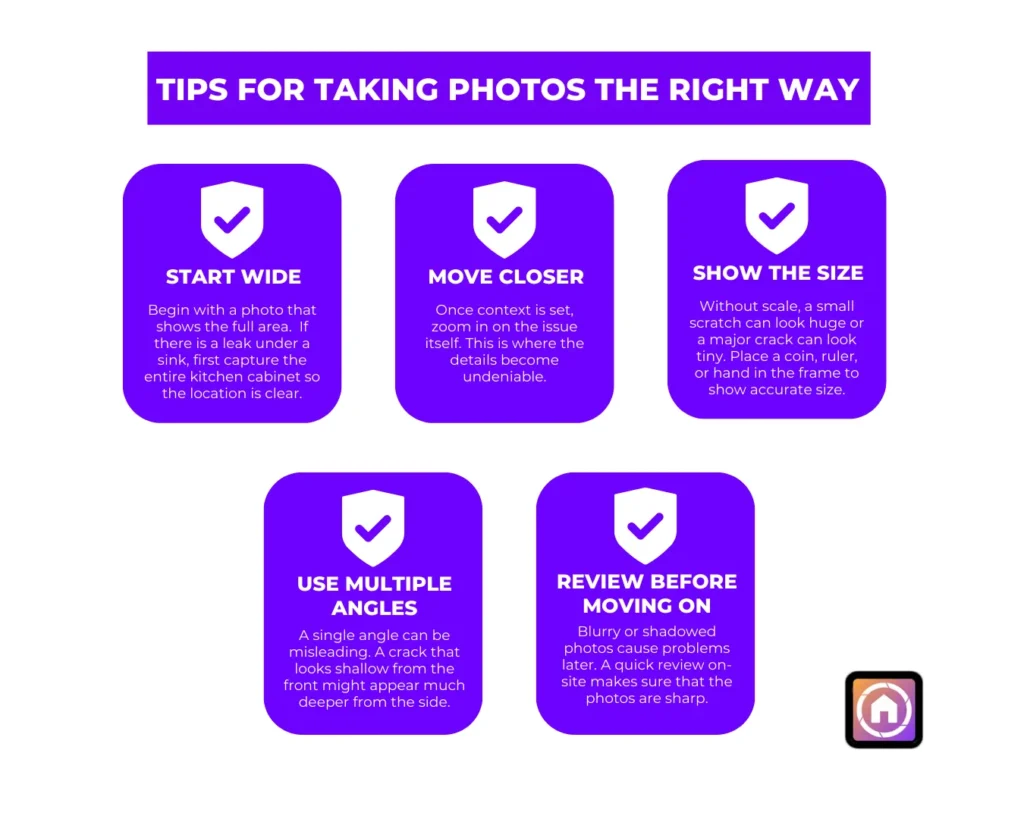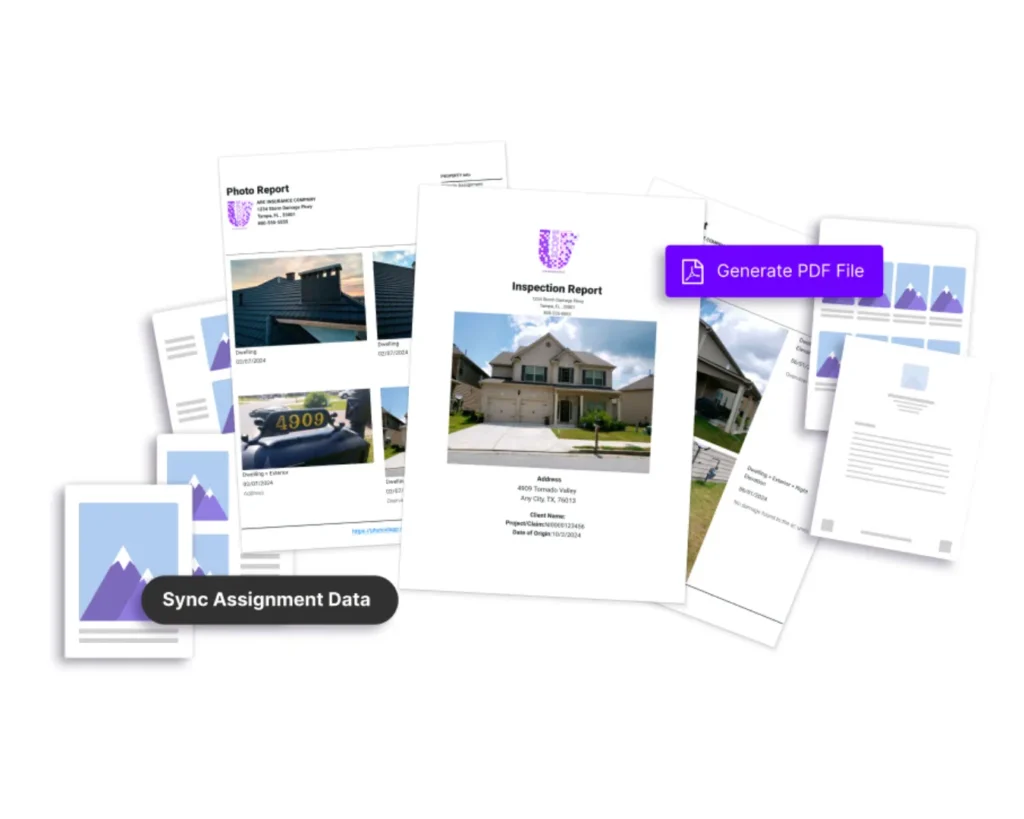A property manager in Florida once faced a heated dispute with a tenant. The tenant claimed the scratched hardwood floors were already damaged before move-in. The property manager argued otherwise. The problem? The inspection report had no photos, only notes. With no visual proof, the judge sided with the tenant, and the landlord had to cover thousands in repair costs.
All of this could have been avoided with a few simple photos.
This scenario is not rare. Across property management, construction, insurance, and safety inspections, photos are often the difference between winning a dispute and losing it. They capture the truth when words fall short.
This guide explains how to document inspections with photos in a way that tells a complete story. Along the way, you will see why the right photo at the right time can protect your work, your clients, and your reputation.
Why Photos Tell the Truth Better Than Words
Think like this, you write in your notes, “small crack in wall.” Later, the contractor looks at it and says, “That crack is minor, not worth fixing.” The client disagrees and insists it is much larger. Without a photo, who is right? Both. Or neither.
A photo ends the argument. It shows the exact size, shape, and location of the crack.
That is the power of inspection photos:
- They capture details that words cannot.
- They provide proof when disputes arise.
- They create a timeline of changes over time.
- They build trust with clients who can see what the inspector saw.
Words explain. Photos and Videos prove.
Preparing Before You Take Photos
Every experienced inspector knows the real work starts before the first photo is taken. Without preparation, you end up with blurry shots, missing details, or worse, no usable photos at all.
To set up for success:
- Check your tools:Clean the camera lens, charge the device (your phone or a camera), and confirm there is storage space.
- Walk the space first:Take a quick tour and decide on the flow of photos. Move room to room or follow a top-to-bottom approach.
- Plan for light:Dark corners and basements almost always need extra lighting. Use a strong flashlight or PHOTO iD’s in-camera flashlight so you never miss out on any inch.
- Think about the story:Always ask yourself: how will these photos make sense to someone who was not here today? That mindset changes how you shoot.
Skipping these steps can mean incomplete records, wasted time, and frustrated clients. Preparation is insurance against mistakes.
Tips for taking photos the right way
Random snapshots lead to confusion later. Instead, each photo or video should be taken with intent and treated as part of a bigger story.

1) Start wide
Begin with a photo that shows an overview of the full area. If there is a leak under a sink, first capture the entire kitchen cabinet so the location is clear.
2) Move closer
Once context is set, zoom in on the issue itself. This is where the details become undeniable.
3) Show the size
Without scale, a small scratch or dent can look huge or a major crack or hole can look tiny. Place a coin, ruler, or hand in the frame to show accurate size.
4) Use multiple angles
A single angle can be misleading. A crack that looks shallow from the front might appear much deeper from the side. Angles eliminate doubt.
5) Review before moving on
Blurry or shadowed photos cause problems later. A quick review on-site makes sure that the photos are sharp and usable.
Organizing Photos So They Make Sense
Even the best photos lose their value if they are buried in a disorganized folder. Strong documentation depends on clear and detailed photo organization.
Follow these methods:
- Rename files:Replace image name by creating a workflow with custom category folders such as “House > Interior > Kitchen” or “Building > Roof > Front Slope”
- Add voice-to-text captions:Short notes like “Cracked window from baseball; Missing shingle on the left slope; Water stain on the ceiling from plumbing leak.
- Keep a consistent order:Exterior to interior or top floor to bottom, but always the same approach.
- Use compass or pitch gauge:Enable the in-camera compass to obtain the property’s cardinal directions or the in-camera pitch gauge to record the roof pitch on each slope
Organized photos tell a clear, easy-to-follow story. Disorganized ones leave the story untold and raises red flags, which leads to claim denials.
Mistakes That Weaken Reports
Sloppy photo documentation is one of the fastest ways to lose credibility. Some of the most common mistakes include skipping wide shots, taking too few photos, using heavy filters or editing, relying on memory instead of labels, and forgetting to back up files.
These errors not only weaken the report but also leave room for disputes that could have been avoided with clearer evidence. In many cases, the smallest gap in documentation becomes the biggest source of conflict. Each mistake creates doubt, and in inspections, doubt almost always costs money.
Weaving Photos into Reports
Photos should not sit in a gallery at the end of the report. They should guide the reader alongside the notes, almost as if walking through the space together.
- Place each photo with the note caption it supports.
- Use arrows or highlights only when the issue is hard to spot.
- Keep captions simple: “Water heater rusted at the base from long-term wear”is enough.
- Avoid photo overload. A few strong images communicate better than a flood of similar ones.
When used correctly, photos transform a report into a clear and persuasive story.

The Long-Term Value of Photo Records
The photos captured today may prevent disputes years later. Property managers rely on move-in and move-out photos to protect against false claims, contractors use progress photos to confirm milestones, insurance adjusters depend on damage photos to speed up claims, and safety officers depend on photos to prove compliance with Occupational Safety and Health Administration (OSHA) requirements. While an inspection may only last a single day, the photos taken during it can safeguard the results for years to come.
A seasoned inspector once shared a rule worth remembering: “Take every photo as if it might be reviewed in a courtroom one day.”
This mindset will change everything. Each photo will become more than just a snapshot. It will become evidence, proof, and protection.
The formula is simple. Start wide, zoom in, show scale, and use angles. Organize the photos and videos clearly, pair them with notes, and keep them sharp.
The photo or video taken today might be the one that saves tomorrow.
